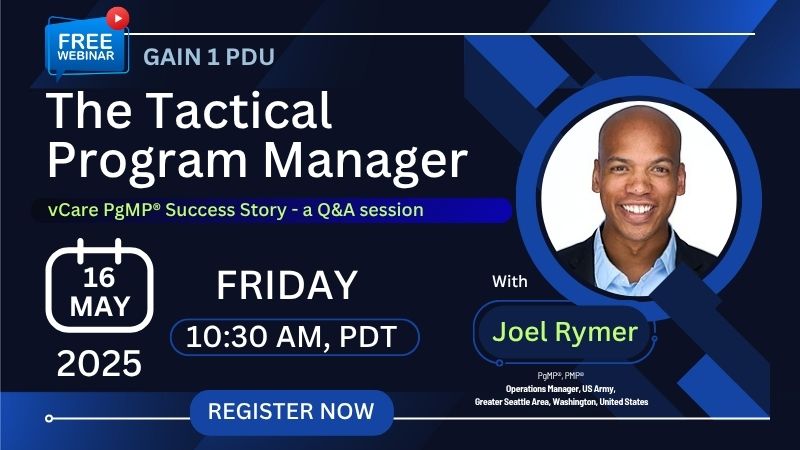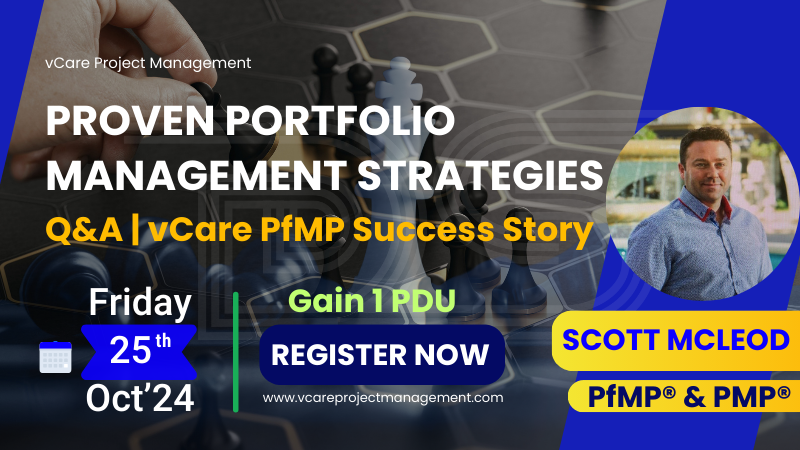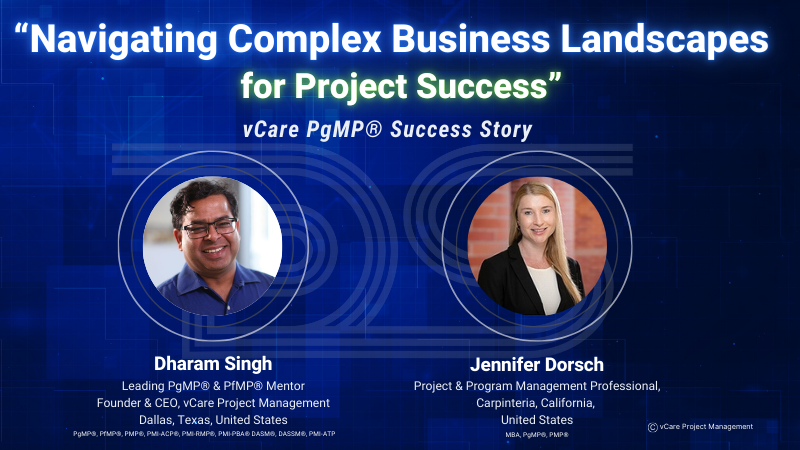


Influencing Organizational Culture with Jeffery Porter – Live Session on April 24
🚀 Discover Actionable Strategies to Influence Organizational Culture!
Join us for an insightful session with Jeffery Porter, a respected authority in Project, Program, and Portfolio Management from Beatrice, Nebraska, USA.
With over 15+ years of experience managing multi-million-dollar portfolios and leading cultural transformations, Jeffery has helped organizations bridge the gap between strategy and culture—delivering consistent and impactful results.
🔗 Reserve your spot now: https://bit.ly/4ifsEsy
🧭 What You’ll Learn
✔ Understanding and Assessing Organizational Culture
✔ Aligning Cultural Initiatives with Strategic Goals
✔ The Role of Managers in Shaping Culture
✔ Case Study: Driving Positive Cultural Change
✔ Measuring the Impact of Culture-Driven Initiatives
✔ Thriving in Challenging Organizational Cultures
🎯 Don’t miss this opportunity to earn 1 PDU, gain valuable career and certification insights, and unlock exclusive offers on PMP, PgMP, and PfMP programs from vCare Project Management.
📅 Session Date: Thursday, 24th April 2025
🕒 Session Time:
11:00 AM – 12:00 PM (PDT) / 12:00 PM – 01:00 PM (MDT) / 01:00 PM – 02:00 PM (CDT) / 02:00 PM – 03:00 PM (EDT) / 03:00 PM – 04:00 PM (BRT) / 07:00 PM – 08:00 PM (BST)
08:00 PM – 09:00 PM (CEST) / 09:00 PM – 10:00 PM (AST) / 10:00 PM – 11:00 PM (GST)
View our upcoming PgMP® Programs
Online → http://bit.ly/2oBKQXQ
Direct → http://bit.ly/2oCfpg0
View our upcoming PfMP® Programs:
Online → http://bit.ly/39jOZSf
Direct → http://bit.ly/38er2M3
🎙️ Got questions about your Project Management career or PMI certifications?
Book your FREE 15-min session with me at 👉 www.talktodharam.com
📞 Contact Us
📱 Call: +1 650-283-0123 (U.S.)
📧 Email: [email protected]
🎧 Subscribe & Stay Ahead
Success Stories: https://bit.ly/2YF0wJl
Podcasts & Interviews: https://bit.ly/2NDY8wd
#ProjectManagement #PgMP #PfMP #PMP #PMICertifications #Leadership #vCareProjectManagement #OrganizationalExcellence #DharamSinghPfMP #DharamSinghPgMP #PgMPTraining #JefferyPorter

Mastering Stakeholder Management – 7 Principles for Program & Portfolio Leaders
🔑 Mastering Stakeholder Management: A Non-Negotiable for Program & Portfolio Success
Whether you’re managing a single project or steering an enterprise-wide transformation, your ability to influence and align stakeholders can make or break success.
I’ve distilled my learnings into 7 powerful principles of stakeholder management — essential for every Project, Program, and Portfolio Manager:
1️⃣ Identify Stakeholders – Recognize key individuals who impact or are impacted by your project.
2️⃣ Understand Their Needs – Assess stakeholder expectations, interests, and concerns for better alignment.
3️⃣ Maintain Transparency – Provide clear, honest, and timely communication to build trust.
4️⃣ Engage Proactively – Actively involve stakeholders to prevent misunderstandings and conflicts.
5️⃣ Manage Conflicts Respectfully – Address stakeholder concerns with diplomacy and mutual respect.
6️⃣ Align Interests and Goals – Find common ground to create win-win outcomes for all stakeholders.
7️⃣ Foster Long-Term Relationships – Strong stakeholder relationships drive continuous success and trust.
Each principle empowers you to build trust, mitigate resistance, and ensure strategic alignment at every level. 💼🌍
👉 Swipe through the carousel to dive deeper into each principle.
💬 Which of these principles do you apply consistently? Which one challenges you the most? Drop your thoughts below!
🔁 Save this post for your next stakeholder engagement planning session.
📌Need expert guidance? Book a free consultation -> http://talktodharam.com
Contact Us:
Call us: +1 650-283-0123 (U.S.)
Email: [email protected]
Subscribe for More:
Webinars & Success Stories https://bit.ly/2YF0wJl
Podcasts and Interviews: https://bit.ly/2NDY8wd
🔔 Follow me for more insights on PgMP, PfMP, and strategic leadership.
#StakeholderManagement #ProgramManagement #PortfolioManagement #PgMP #PfMP #Leadership #StrategyExecution #ProjectLeadership #vCareProjectManagement #DharamSingh #PMICertification #ChangeManagement #InfluenceLeadership

Proven Portfolio Management Strategies | Scott McLeod | vCare PfMP Webinar | Dharam Singh
Proven Portfolio Management Strategies | Scott McLeod | vCare PfMP Success Story
I am excited to announce an exclusive webinar featuring Scott McLeod A.Sc.T, PMP, PfMP, a renowned industry leader in project and portfolio management, as the guest keynote speaker. This webinar promises to provide valuable insights into the evolving world of portfolio management.
Discussion Topics include but are not limited to,
• Role of certifications in ongoing professional development
• The importance of agility in portfolio management
• Aligning projects with organizational strategic goals
• How digital tools transform portfolio management processes
• Managing stakeholder expectations in large-scale projects
Attendees will gain expert knowledge, earn 1 PDU, and enjoy a special discount code for our upcoming PMP, PgMP, and PfMP programs.
🔗 Reserve your spot now: https://bit.ly/3Mx38kN
Session Date: Friday, 25TH October 2024
Session Time: 10:30 AM – 11:30 AM (PDT) / 11:30 AM – 12:30 PM (MDT) / 12:30 PM – 01:30 PM (CDT) / 01:30 PM – 02:30 PM (EDT) / 02:30 PM – 03:30 PM (BRT) / 06:30 PM – 07:30 PM (BST) / 07:30 PM – 08:30 PM (CEST) / 08:30 PM – 09:30 PM (AST) / 09:30 PM – 10:30 PM (GST)
🚀 Elevate Your Project Management Career:
– Book an obligation-free consultation session on Project Management Career, training, and certifications: http://talktodharam.com
– Discover training offers and certification discounts: https://bit.ly/3jWVepD
– Stay updated with our Q&A series and certification success stories by subscribing to the vCare Project Management YouTube channel at https://bit.ly/2YF0wJl
– Follow my podcasts and interviews with Project Management Experts on YouTube at https://bit.ly/2NDY8wd
#portfoliomanagementstrategies #portfoliomanagement #pfmp #pfmpwebinar #projectmanagement #agilemanagement #professionaldevelopment #vcaresuccess #digitaltransformation #stakeholdermanagement #projectsuccess #managementstrategies #certificationsmatter #strategicalignment #agilityinprojects #projectleadership #pmcommunity #pmi #askdharam #dharamsingh #vcareprojectmanagement

Navigating Business Complexity for Project Success | Q&A with Jennifer Dorsch & Dharam Singh
Navigating Complex Business Landscapes for Project Success | Q&A | Jennifer Dorsch | Dharam Singh
🔍 Key Takeaways:
– How do you balance strategic alignment and operational flexibility in managing large-scale transformation projects?
– How effectively have you seen organizations blend predictive and agile practices to address diverse project challenges and needs? Are hybrid management frameworks gaining traction as a fit-for-purpose approach?
– Can you share a successful case where agile and traditional project management methods were integrated into a large-scale project?
– In the face of technological disruption, why do you think emerging leadership imperatives embrace agility and skill to thrive in an uncertain and changing environment?
– What are the key factors for fostering innovation and adaptability in project teams?
🎥 Watch now: https://www.youtube.com/watch?v=OPMUWIidYrU
🚀 Seize the opportunity to Elevate Your Project Management Career:
– Register for my upcoming PMI Certification Success Story Webinars: https://bit.ly/4fJdX0c / https://bit.ly/4fFJTTn
– Book an obligation-free consultation session on Project management Career, training, and certifications: http://talktodharam.com
– Discover training offers and certification discounts: https://bit.ly/3jWVepD
– Stay updated with our Q&A series and certification success stories by subscribing to the vCare Project Management YouTube channel at https://bit.ly/2YF0wJl
– Follow my podcasts and interviews with Project Management Experts on YouTube at https://bit.ly/2NDY8wd
#ProjectManagement #Leadership #Innovation #Agility #BusinessSuccess #AgileLeadership #Transformation #Innovation #HybridManagement #LeadershipDevelopment #BusinessStrategy #OrganizationalAgility #ChangeManagement #ProjectSuccess #TeamAdaptability #StrategicAlignment #OperationalExcellence #EmergingTrends #PgMP #PfMP #PMP #AskDharam #DharamSingh #VCareProjectManagement





Join me for an exclusive vCare Project Management webinar featuring Joel Rymer, Operations Manager in the U.S. Army and newly certified PgMP® professional based in Seattle, Washington.🔗 Register now: https://bit.ly/4jnDBJH
🗓 Date: Friday, 16th May 2025
⏰ Time: 10:30 AM – 11:30 AM (PDT) / 11:30 AM – 12:30 PM (MDT)
12:30 PM – 01:30 PM (CDT) / 01:30 PM – 02:30 PM (EDT)
02:30 PM – 03:30 PM (BRT) / 07:30 PM – 08:30 PM (CEST)
08:30 PM – 09:30 PM (AST) / 09:30 PM – 10:30 PM (GST)
This session will explore:
– Redefining Tactical Leadership in Program Management
– Aligning Tactical Actions with Strategic Intent
– Performance Metrics in Agile Operational Contexts
– Decision-Making Under Pressure: Balancing Policy and Practicality
– Stakeholder Engagement Through a Military-Strategic Lens
– Tactical Pivots That Saved the Strategy
As your host, I look forward to guiding this engaging discussion with Joel, bringing real-world program management insights from the field to the boardroom. Attendees will earn 1 PDU, access special discounts on our PMP®, PgMP®, and PfMP® programs, and walk away with actionable insights to advance their careers.